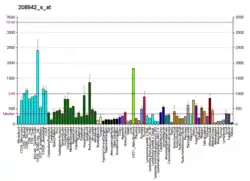SEC62
Translocation protein SEC62 is a protein that in humans is encoded by the SEC62 gene.[5][6][7]
| SEC62 | |||||||||||||||||||||||||||||||||||||||||||||||||||
|---|---|---|---|---|---|---|---|---|---|---|---|---|---|---|---|---|---|---|---|---|---|---|---|---|---|---|---|---|---|---|---|---|---|---|---|---|---|---|---|---|---|---|---|---|---|---|---|---|---|---|---|
| Identifiers | |||||||||||||||||||||||||||||||||||||||||||||||||||
| Aliases | SEC62, Dtrp1, HTP1, TLOC1, TP-1, SEC62 homolog, preprotein translocation factor | ||||||||||||||||||||||||||||||||||||||||||||||||||
| External IDs | OMIM: 602173 MGI: 1916526 HomoloGene: 2449 GeneCards: SEC62 | ||||||||||||||||||||||||||||||||||||||||||||||||||
| |||||||||||||||||||||||||||||||||||||||||||||||||||
| |||||||||||||||||||||||||||||||||||||||||||||||||||
| |||||||||||||||||||||||||||||||||||||||||||||||||||
| |||||||||||||||||||||||||||||||||||||||||||||||||||
| |||||||||||||||||||||||||||||||||||||||||||||||||||
| Wikidata | |||||||||||||||||||||||||||||||||||||||||||||||||||
| |||||||||||||||||||||||||||||||||||||||||||||||||||
Function
The Sec61 complex is the central component of the protein translocation apparatus of the endoplasmic reticulum (ER) membrane. The protein encoded by this gene and SEC63 protein are found to be associated with ribosome-free SEC61 complex. It is speculated that Sec61-Sec62-Sec63 may perform post-translational protein translocation into the ER. The Sec61-Sec62-Sec63 complex might also perform the backward transport of ER proteins that are subject to the ubiquitin-proteasome-dependent degradation pathway. The encoded protein is an integral membrane protein located in the rough ER.[7]
References
- GRCh38: Ensembl release 89: ENSG00000008952 - Ensembl, May 2017
- GRCm38: Ensembl release 89: ENSMUSG00000027706 - Ensembl, May 2017
- "Human PubMed Reference:". National Center for Biotechnology Information, U.S. National Library of Medicine.
- "Mouse PubMed Reference:". National Center for Biotechnology Information, U.S. National Library of Medicine.
- Daimon M, Susa S, Suzuki K, Kato T, Yamatani K, Sasaki H (Feb 1997). "Identification of a human cDNA homologue to the Drosophila translocation protein 1 (Dtrp1)". Biochem Biophys Res Commun. 230 (1): 100–4. doi:10.1006/bbrc.1996.5892. PMID 9020021.
- Meyer HA, Grau H, Kraft R, Kostka S, Prehn S, Kalies KU, Hartmann E (Jun 2000). "Mammalian Sec61 is associated with Sec62 and Sec63". J Biol Chem. 275 (19): 14550–7. doi:10.1074/jbc.275.19.14550. PMID 10799540.
- "Entrez Gene: TLOC1 translocation protein 1".
Further reading
- Daimon M, Susa S, Kato T (2000). "Fine structure of the human translocation protein 1 (HTP1/TLOC1) gene". IUBMB Life. 48 (6): 619–24. doi:10.1080/713803565. PMID 10683767. S2CID 10297001.
- Strausberg RL, Feingold EA, Grouse LH, et al. (2003). "Generation and initial analysis of more than 15,000 full-length human and mouse cDNA sequences". Proc. Natl. Acad. Sci. U.S.A. 99 (26): 16899–903. Bibcode:2002PNAS...9916899M. doi:10.1073/pnas.242603899. PMC 139241. PMID 12477932.
- Ota T, Suzuki Y, Nishikawa T, et al. (2004). "Complete sequencing and characterization of 21,243 full-length human cDNAs". Nat. Genet. 36 (1): 40–5. doi:10.1038/ng1285. PMID 14702039.
- Gerhard DS, Wagner L, Feingold EA, et al. (2004). "The Status, Quality, and Expansion of the NIH Full-Length cDNA Project: The Mammalian Gene Collection (MGC)". Genome Res. 14 (10B): 2121–7. doi:10.1101/gr.2596504. PMC 528928. PMID 15489334.
- Jung V, Kindich R, Kamradt J, et al. (2006). "Genomic and expression analysis of the 3q25-q26 amplification unit reveals TLOC1/SEC62 as a probable target gene in prostate cancer". Mol. Cancer Res. 4 (3): 169–76. doi:10.1158/1541-7786.MCR-05-0165. PMID 16547154.
- Lim J, Hao T, Shaw C, et al. (2006). "A protein-protein interaction network for human inherited ataxias and disorders of Purkinje cell degeneration". Cell. 125 (4): 801–14. doi:10.1016/j.cell.2006.03.032. PMID 16713569. S2CID 13709685.
- Olsen JV, Blagoev B, Gnad F, et al. (2006). "Global, in vivo, and site-specific phosphorylation dynamics in signaling networks". Cell. 127 (3): 635–48. doi:10.1016/j.cell.2006.09.026. PMID 17081983. S2CID 7827573.
This article is issued from Wikipedia. The text is licensed under Creative Commons - Attribution - Sharealike. Additional terms may apply for the media files.





